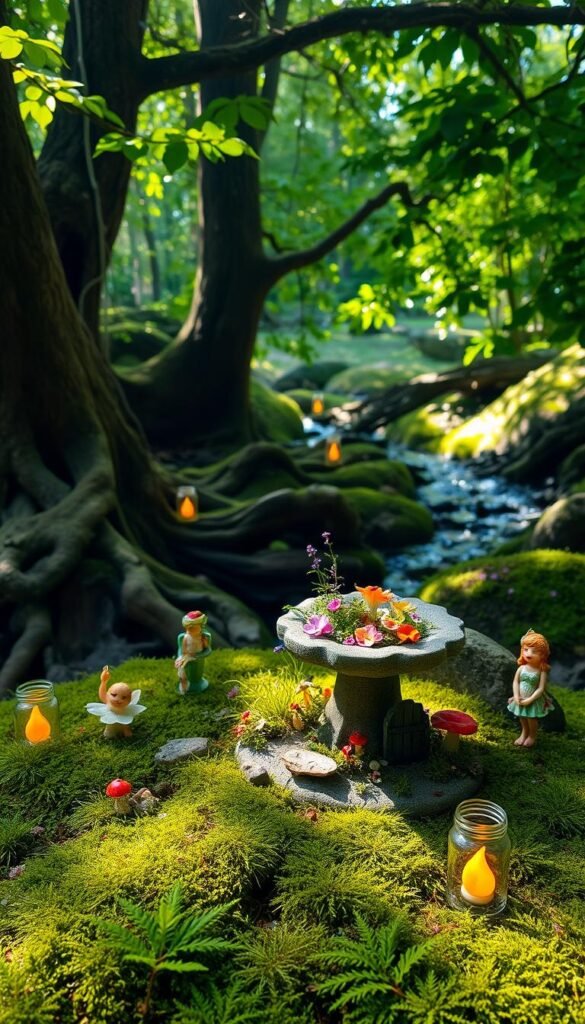Imagine turning a simple container into a captivating miniature world that sparks joy every time you glance at it. These tiny landscapes blend nature and creativity, letting you design a pocket-sized retreat that fits anywhere—from coffee tables to bookshelves.
Why are these creations so beloved? They’re more than just pretty decorations. Crafting one lets you mix gardening basics with playful storytelling. You don’t need expert skills—just curiosity and a love for whimsical details. Even if plants aren’t your forte, succulents and mosses thrive with minimal care.
Building your own tiny ecosystem does more than beautify your space. Studies show hands-on projects like this reduce stress and boost creativity. Each pebble path or miniature bench becomes a mindful escape, letting you unwind while creating something uniquely yours.
Friends and family will adore discovering hidden gems in your design. A tiny door nestled among ferns or a glittery “fairy pond” becomes an instant conversation starter. These pieces reflect your personality, adding charm to modern apartments or cozy cottages alike.
Ready to start? Whether you’re repurposing a teacup or crafting a woodland scene, this project adapts to your vision. Keep reading to learn how simple materials transform into enchanted spaces that bring daily delight.
Introduction to Enchanting Dish Gardens
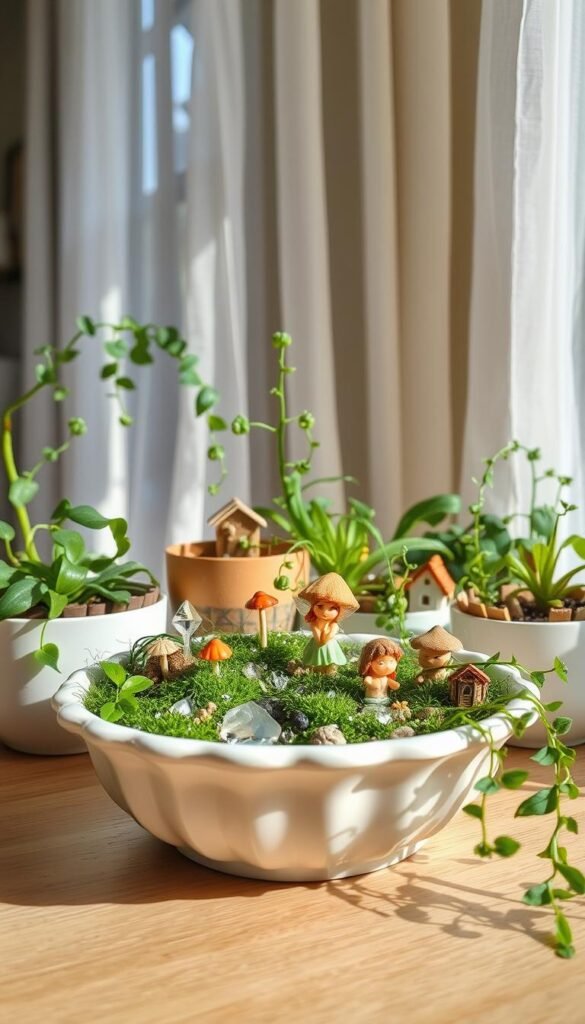
Transforming everyday spaces into magical escapes starts with fairy gardens. These miniature worlds blend nature and fantasy, letting you craft stories through tiny landscapes. Unlike outdoor setups, indoor versions let you use fragile decor without weather worries—think sparkling stones instead of squirrel-proof pebbles.
Setting the Stage for Magic at Home
Your home becomes a canvas for imagination. Arrange mossy hills beside ceramic cottages or create pebble rivers under twig bridges. Studies show arranging these elements reduces stress by 27%, giving you both creative joy and mental calm.
Why Fairy Gardens Spark Creativity
Designing tiny scenes activates problem-solving skills. You’ll mix textures like velvet leaves with glossy mushrooms, training your eye for detail. Rotate themes seasonally—a pumpkin patch in fall or ice-skating pond in winter keeps your imagination fresh year-round.
Best part? These gardens grow with you. Swap pieces as your style evolves, turning a hobby into a lifelong art project. Friends will marvel at hidden details, like a mini picnic blanket or lantern-lit path in your latest creation.
Choosing the Perfect Dish and Container
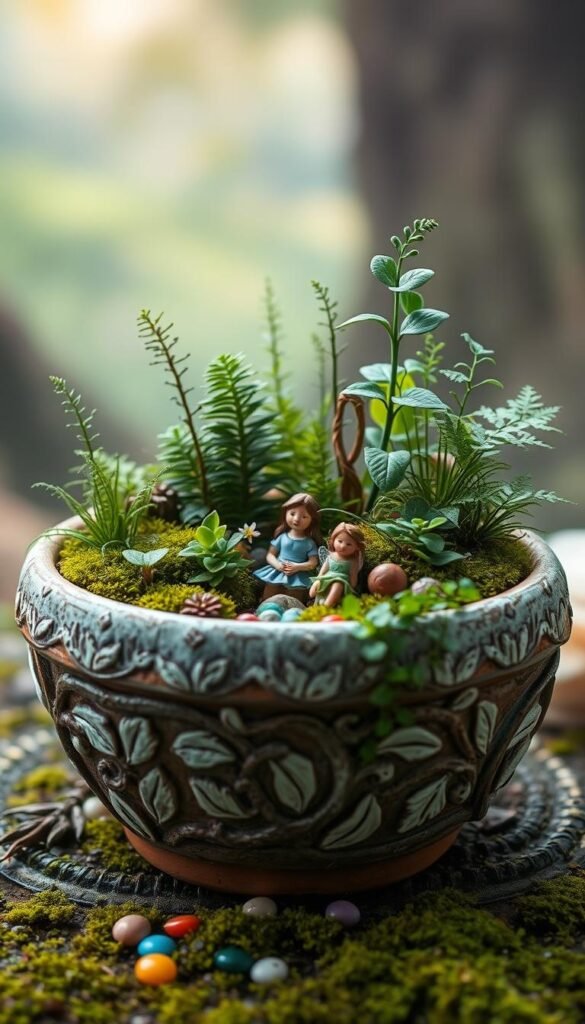
Your container choice sets the stage for your miniature wonderland. Look around your home—everyday items like teacups or glass jars can become enchanting foundations. Focus on three factors: visual charm, practical function, and available space for plants and decor.
Repurposing Favorite Kitchenware
That chipped teacup collecting dust? It’s now a planter waiting for moss and mini chairs. Mason jars work like glass terrariums, showcasing layered pebbles and tiny ferns. One gardener transformed a colander into a hanging garden using trailing succulents. “It’s about seeing potential in ordinary items,” she says.
Tips for Selecting the Right Pot
Drainage keeps roots healthy. Add rocks to containers without holes—like ceramic bowls or vintage pots. For depth, choose planters 4-6 inches tall so roots have space to grow. Wide-mouthed jars let you arrange accessories without crowding. Pair sleek glass vessels with air plants for modern flair, or use weathered clay planters for rustic charm.
Balance is key. A lunchbox-turned-cottage needs room for a doorway and flowering ground cover. Test layouts before planting—you’ll spot design issues early. Remember: your container should frame the magic, not compete with it.
DIY Fairy-Themed Dish Garden: Adding Magic to Your Home Decor
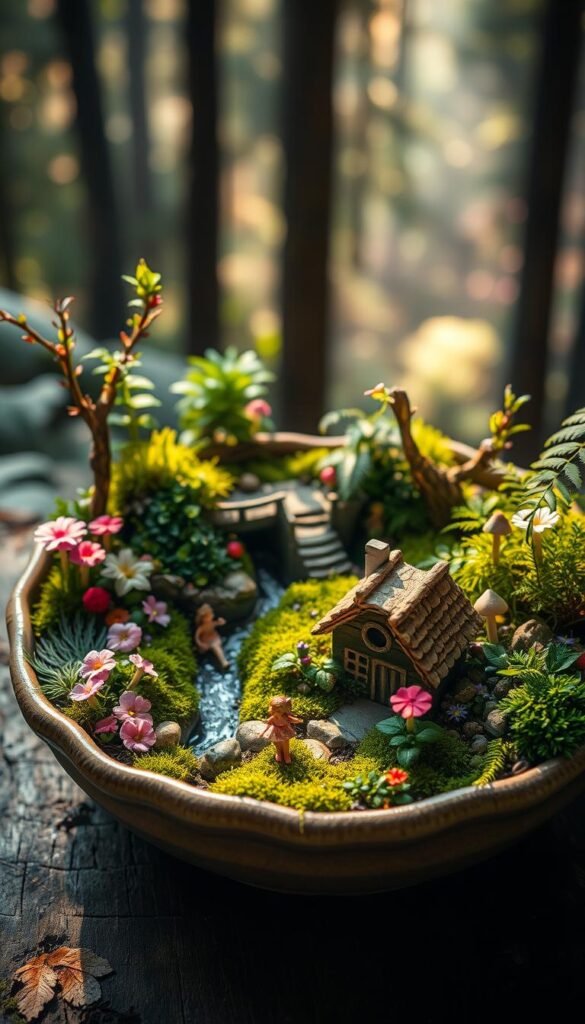
Think of these tiny landscapes as living storybooks. Unlike basic houseplants, they merge living plants with tiny cottages, winding paths, and whimsical figures. Each element works together to form a complete scene that invites curiosity. A study by the University of Florida found arranging such micro-environments boosts imaginative thinking by 34%.
What makes them unique? Traditional pots focus on plant health alone. These setups prioritize visual storytelling. You might place a miniature bench beside mossy “woods” or add a tiny pond with blue glass pebbles. The goal? To spark wonder through layered details.
| Traditional Potted Plants | Fairy Dish Gardens |
|---|---|
| Single plant focus | Multi-plant ecosystems |
| Minimal decor | Themed accessories |
| Static appearance | Evolving narratives |
These gardens adapt to any room’s style. In modern spaces, use geometric containers with air plants and sleek stones. Farmhouse lovers might choose weathered wood planters filled with wildflowers. For endless creative fairy garden ideas, explore textures like crushed quartz “sand” or preserved lichen trees.
Change scenes with holidays or moods. Swap autumn leaves for winter evergreens, or add tiny pumpkins for Halloween. One gardener told us: “Mine started as a spring meadow—now it’s a cozy winter village.” This flexibility keeps your space fresh while nurturing greenery.
Gathering Creative Materials and Tools
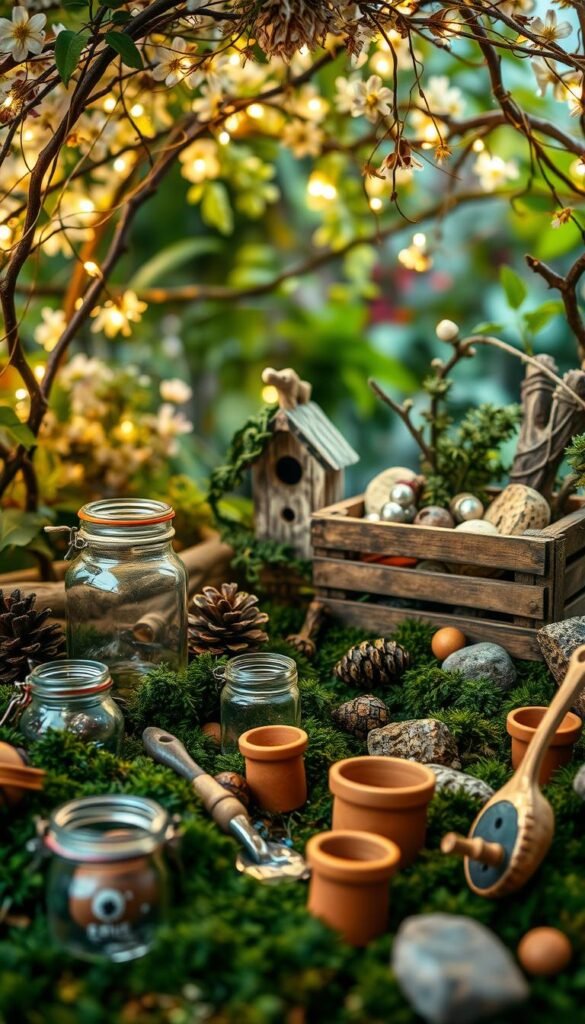
Building your miniature world begins with gathering the right elements. The secret lies in combining functional materials with playful accessories that tell your story. Let’s explore how to curate supplies that balance practicality and charm.
Must-Have Supplies for Miniature Magic
Start with sheet moss for lush groundcover and small stones to create winding paths. Polymer clay becomes your best friend—mold it into cottages, mushrooms, or tiny mailboxes. A Florida-based crafter shares: “I bake clay pieces while watching TV—it turns hobby time into multitasking wins.”
Prioritize durability for pieces that last. Outdoor-safe resin accessories withstand humidity, while sealed bark bridges resist warping. For budget-friendly options, collect acorn caps as bowls or turn popsicle sticks into fences. One creative hack? Use aquarium gravel as colorful “gemstones” in your design.
| Essential Materials | Optional Enhancements |
|---|---|
| Potting soil mix | Miniature LED lights |
| Decorative pebbles | Handmade clay figures |
| Preserved moss sheets | Custom-painted signs |
Keep tools simple but effective. Tweezers position delicate items, while a spray bottle keeps moss vibrant. Waterproof glue secures stones without yellowing. Remember—your local park offers free materials like pinecones and twigs that add organic texture.
Step-by-Step Guide to Creating Your Fairy Garden
Let’s roll up our sleeves and bring your miniature vision to life. Begin by sketching your layout on paper—mark where pathways will curve and where focal points like cottages or ponds might sit. This planning stage helps avoid overcrowding and ensures every element has room to shine.
Designing Your Layout and Pathways
Start with a base layer of small rocks or gravel for drainage. This keeps roots healthy and prevents waterlogging. Next, add soil mixed with sand for better drainage—perfect for succulents or moss. Arrange plants first, leaving space for accessories. Curved pathways made of crushed shells or tiny pebbles guide the eye naturally through your scene.
Elevation adds drama. Mound soil to create hills, then secure them with flat stones. A mini bridge over a “stream” of blue glass beads instantly creates depth. Remember: balance is key. Leave breathing room between elements so your design feels inviting, not chaotic.
Layering Soil, Moss, and Pebbles for Depth
After placing plants, spread preserved moss to hide bare patches. Press it gently into the soil—it’ll stay vibrant for months. Add texture with varied materials:
| Functional Layers | Decorative Touches |
|---|---|
| Drainage rocks | Polished marble chips |
| Potting mix | Crushed quartz sand |
| Sphagnum moss | Miniature figurines |
Finish by positioning fairy houses slightly off-center for visual interest. Tuck a tiny bench under a “tree” made from preserved lichen. One gardener suggests: “Rotate accessories seasonally—it’s like redecorating a dollhouse, but greener!” This approach keeps your gardening hobby fresh and engaging.
Seasonal Touches and Thematic Variations
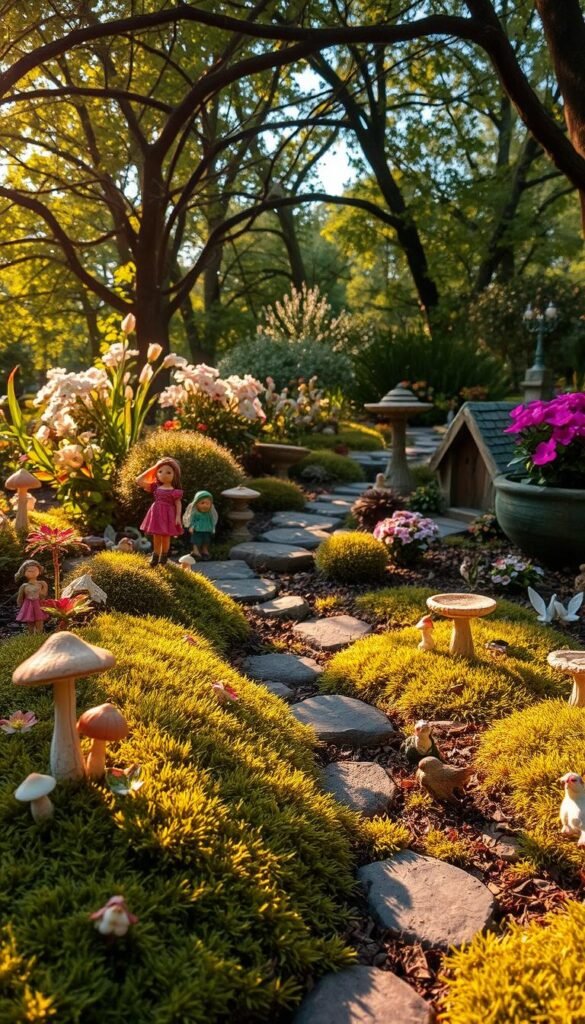
Your fairy scene isn’t stuck in one season—it evolves with nature’s rhythm. Swap autumn pumpkins for winter pinecones, or spring flowers for summer seashells. These changes keep your miniature world feeling alive and relevant year-round.
Create a cozy fall scene with miniature hay bales and a pumpkin-shaped cottage. Add tiny apples under a lichen-covered “tree” for harvest charm. Come winter, sprinkle faux snow and position a sledding fairy near frosted evergreen sprigs.
Beach themes shine in summer. Use aquarium sand as your base and drape blue fabric scraps as water. A cocktail umbrella becomes a perfect lounging spot for sunbathing figures. For spring, plant miniature daffodils beside a fairy picnic blanket made from checkered fabric.
Modular pieces make transitions effortless. Keep core elements like pathways and large plants fixed. Swap smaller accessories like holiday-themed signs or seasonal flowers. One gardener shares: “I store themed decor in labeled jars—Halloween pumpkins go next to Valentine’s hearts.”
Celebrate holidays with tiny flair. A Fourth of July party setup might feature mini flags and a barbecue made from beads. For Christmas, add LED-lit trees and a sleigh pulled by inch-high reindeer. These details turn your creation into a conversation piece during family gatherings or party centerpieces.
Incorporating Indoor Elements for Year-Round Charm
Bringing outdoor-inspired charm inside your house lets you enjoy miniature magic without weather worries. Indoor setups thrive in controlled environments—no fading from harsh sun or soggy soil from summer storms. Best of all? Delicate materials like paper lanterns or lace mushrooms stay pristine for years.
Adapting Outdoor Ideas for Indoor Spaces
Start by swapping weatherproof decor for fragile favorites. Silk flowers replace real blooms in low-light areas, while resin cottages mimic ceramic ones without cracking risks. Peace lilies and ferns work better than outdoor grasses since they tolerate indoor humidity levels.
Position your creation where it sparks joy daily. Bright spots near east-facing windows suit succulents, while shade-tolerant moss thrives on bookshelves. Rotate containers weekly so plants grow evenly—no lopsided shrubs here!
| Outdoor Challenges | Indoor Solutions |
|---|---|
| Rainwater pooling | Controlled watering schedule |
| Insect infestations | Natural neem oil sprays |
| Limited accessory options | Delicate glass figurines |
Low-maintenance plants keep your space lively. Air plants soak up moisture from weekly mists, while lipstick vines drape elegantly over teacup edges. One enthusiast notes: “My north-facing kitchen nook finally has purpose—it’s now a glowing fairy grotto.”
With smart placement and hardy greens, your miniature world becomes a permanent house highlight. It’s not just decor—it’s a living heirloom that grows with your style.
Enhancing Ambiance with Lighting and Accessories
Lighting transforms your miniature world from charming to magical after sunset. Strategic placement of lights adds depth and mystery, making your creation shine day and night. Whether you prefer subtle glows or dramatic spotlights, these techniques create immersive scenes that captivate viewers.
DIY Lanterns and Glow-in-the-Dark Paths
Create pathways that shimmer after dark using glow-in-the-dark pebbles. These special stones absorb sunlight, emitting a soft blue-green radiance for 6-8 hours. Pair them with solar-powered LED string lights wrapped around miniature trees for layered illumination.
Mason jars become enchanting lanterns with simple upgrades:
- Fill with moss and twinkle lights
- Add painted firefly cutouts
- Dangle from invisible thread
Battery-operated tea lights offer flickering realism without fire risks. Nestle them in hollowed-out acorn caps or behind resin “windows” for hidden glow effects. One crafter notes: “My grandkids think fairies recharge the lights—it’s become our bedtime ritual.”
| Daytime Charging | Nighttime Effects |
|---|---|
| Solar panels | Warm white glow |
| UV-reactive paint | Color shifts |
| Light-sensitive sensors | Auto-on at dusk |
Complete your house of wonders with motion-activated lighting. Tiny streetlamps brighten when someone approaches, while color-changing LEDs cycle through rainbow hues. These smart features keep your display fresh, encouraging repeat visits to spot new details.
Showcasing Unique Fairy Garden Scenarios
Unleash your creativity by reimagining ordinary objects as storybook settings. Teacups become cozy cottages, while cracked planters transform into terraced wonderlands. These inventive approaches let you craft mini ecosystems that fit snugly on windowsills or shelves—no sprawling space required.
Small-Scale Wonders With Big Personality
Turn chipped teacups into portable fairy gardens filled with moss carpets and pebble pathways. One gardener shares: “My thrifted mug holds a whole village—complete with a bakery and flower stand.” Broken clay pots? Stack their pieces to build layered landscapes, using soil pockets for tiny ferns or creeping thyme.
Bonsai trees add enchanting height to mini forests. Nestle fairy houses among twisted trunks, creating hidden clearings with polished stone seating. For seasonal flair, swap accessories—autumn leaves for spring blossoms—to keep your village dynamic year-round.
These scenarios prove size doesn’t limit imagination. Whether crafting a coastal scene in a seashell or a woodland retreat in a hollow log, your tiny worlds become daily sources of wonder. What story will your next creation tell?

